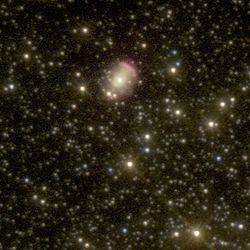| Emission nebula | |
|---|---|
| Planetary nebula | |
 | |
| Observation data: J2000.0 epoch | |
| Distance | 33,600 [1] ly |
| Apparent magnitude (V) | +15.5 [1] |
| Apparent dimensions (V) | 3 arcsecs [1] |
| Constellation | Pegasus |
| Physical characteristics | |
| Radius | 0.24 ly |
| Absolute magnitude (V) | - |
Pease 1 is a planetary nebula located within the globular cluster M15 33,600 light years away in the constellation Pegasus. It was the first planetary nebula known to exist within a globular cluster when it was discovered in 1928 [2] (for Francis G. Pease), and just four more have been found (in other clusters) since. [1] At magnitude 15.5, it requires telescopes with an aperture of at least 300-millimetre (12 in) to be detected. [3]
- ^ a b c d "Globular Cluster M15 and Planetary Nebula Pease 1". www.astropix.com. Archived from the original on 2011-07-18.
- ^ O'Meara, Stephen James; Levy, David H. (1998), Deep-Sky Companions: The Messier Objects, Cambridge University Press, p. 74, ISBN 978-0521553322.
- ^ Dunlop, Storm (2005). Atlas of the Night Sky. Collins. ISBN 0-00-717223-0.
| Emission nebula | |
|---|---|
| Planetary nebula | |
 | |
| Observation data: J2000.0 epoch | |
| Distance | 33,600 [1] ly |
| Apparent magnitude (V) | +15.5 [1] |
| Apparent dimensions (V) | 3 arcsecs [1] |
| Constellation | Pegasus |
| Physical characteristics | |
| Radius | 0.24 ly |
| Absolute magnitude (V) | - |
Pease 1 is a planetary nebula located within the globular cluster M15 33,600 light years away in the constellation Pegasus. It was the first planetary nebula known to exist within a globular cluster when it was discovered in 1928 [2] (for Francis G. Pease), and just four more have been found (in other clusters) since. [1] At magnitude 15.5, it requires telescopes with an aperture of at least 300-millimetre (12 in) to be detected. [3]
- ^ a b c d "Globular Cluster M15 and Planetary Nebula Pease 1". www.astropix.com. Archived from the original on 2011-07-18.
- ^ O'Meara, Stephen James; Levy, David H. (1998), Deep-Sky Companions: The Messier Objects, Cambridge University Press, p. 74, ISBN 978-0521553322.
- ^ Dunlop, Storm (2005). Atlas of the Night Sky. Collins. ISBN 0-00-717223-0.